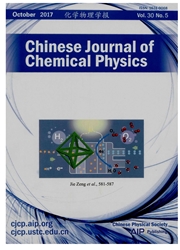

 中文摘要:
中文摘要:
用不同温度控制分解草酸氧钛铵制备N掺杂TiO2光催化剂.利用XRD、IR、热分析、N2吸-脱附等温线、XPS、紫外可见漫反射光谱和SEM表征了N-TiO2光催化剂的结构.400~600 ℃焙烧的N-TiO2光催化剂为纯锐钛矿相,而700 ℃焙烧的N-TiO2光催化剂为锐钛矿和金红石混合相.N掺杂在TiO2的间隙位使锐钛矿相TiO2带隙变窄.在光降解甲基橙的反应中,600和400 ℃焙烧的N-TiO2催化剂分别在紫外光和全波长光照射下有最好活性;700 ℃焙烧的N-TiO2催化剂无论在紫外光和全波长光下都表现出最好的比活性,即最高的光量子效率,这可以归因于700℃焙烧的N-TiO2光催化剂良好的结晶程度和锐钛矿-金红石异相结的存在.
 英文摘要:
英文摘要:
We developed a novel approach for the preparation of N-doped TiO2 photocatalysts by calcining ammonium titanium oxalate at different temperatures. The structures of N-TiO2 were characterized by powder X-ray diffraction, infrared spectroscopy, thermogravimetric analysis, N2 adsorption-desorption isotherms, X-ray photoelectron spectroscopy, diffuse reflectance UV-Vis spectroscopy, and scanning electron microscope. The N-doped TiO2 photocatalysts calcined below 700 ℃ are the pure anatase phase but that calcined at 700 ℃ is a mixture of anatase and rutile phases. The doped N locates at the interstitial site of TiO2 which leads to the narrowing of bad gap of pure anatase N-TiO2. Among all photocatalysts, N-TiO2 photocatalysts calcined at 600 and 400 ℃ exhibit the best performance in the photodegradation of methyl orange under the UV light and all-wavelength light illuminations, respectively; however, because of the perfect crystallinity and the existence of anatase-rutile phase junctions, N-TiO2 photocatalyst calcined at 700 ℃ exhibits the highest specific photodegradation rate, i.e., the highest quantum yield, under both the UV light and all-wavelength light illuminations.
 同期刊论文项目
同期刊论文项目
 同项目期刊论文
同项目期刊论文
 Photocatalytic Activity of N-doped TiO2 Photocatalysts Prepared from the Molecular Precursor (NH4)(2
Photocatalytic Activity of N-doped TiO2 Photocatalysts Prepared from the Molecular Precursor (NH4)(2 A density functional theory study of the CH2I2 reaction on Ag(111): Thermodynamics, kinetics, and el
A density functional theory study of the CH2I2 reaction on Ag(111): Thermodynamics, kinetics, and el Synchrotron-Radiation Photoemission Study of Growth and Stability of Au Clusters on Rutile TiO2(110)
Synchrotron-Radiation Photoemission Study of Growth and Stability of Au Clusters on Rutile TiO2(110) 期刊信息
期刊信息
